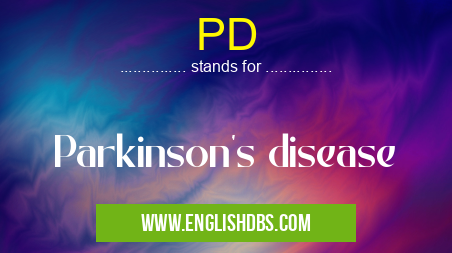What does PD mean in THERAPY
Parkinson's Disease (PD) is a neurological disorder that affects movement, posture, balance and muscle rigidity. It is a chronic, progressive disorder of the nervous system which occurs when nerve cells in an area of the brain called the substantia nigra are lost or damaged. This neurological disorder can cause a range of symptoms including tremor, slowness of movement, stiffness, changes in speech and difficulty with walking and coordination.

PD meaning in Therapy in Medical
PD mostly used in an acronym Therapy in Category Medical that means Parkinson's disease
Shorthand: PD,
Full Form: Parkinson's disease
For more information of "Parkinson's disease", see the section below.
Essential Questions and Answers on Parkinson's disease in "MEDICAL»THERAPY"
What are the symptoms of PD?
Common symptoms of PD include tremor, slowness of movement, stiffness and difficulty with walking and coordination. Other associated symptoms may also be present including difficulty with writing, facial masking (reduced expression), shuffling gait, depression and fatigue.
What causes PD?
The cause of PD is not yet known; however it is thought to result from a combination of genetic and environmental factors. Research suggests that some cases may be caused by mutations in specific genes that regulate the dopamine system in the brain. Exposure to certain chemicals such as pesticides has also been linked to increased risk.
How is PD diagnosed?
Diagnosis of PD involves an extensive assessment by a health care professional including a physical exam and neurological tests to measure balance and mobility. Brain scans such as MRI or CT may also be recommended to look for signs related to PD. Diagnosis also includes ruling out other conditions that have similar symptoms such as multiple system atrophy (MSA) or essential tremor.
Is there a cure for PD?
Currently there is no cure for PD, but medications can help control some of the symptoms such as tremor or slowness of movement. Physical therapy can help improve balance and coordination while other treatments such as deep brain stimulation (DBS), which uses electrical signals sent into specific parts of the brain affected by PD to reduce tremors, can also provide relief from symptoms.
Are there any lifestyle changes I can make to manage my PD symptoms?
Yes! In addition to medication and physical therapy there are several lifestyle modifications you can make to help manage your symptoms such as stress management techniques like yoga or mindfulness practice; regular exercise; avoiding caffeine; eating nutritious foods rich in vitamins; getting adequate rest; minimizing exposures to toxins; quitting smoking if applicable; taking vitamin D supplements if recommended by your doctor etc.
Final Words:
Managing Parkinson's disease requires a comprehensive approach including medication, physical therapy lifestyle modifications etc., under the guidance of health care professionals including neurologists or physiatrists who specialize in this disorder. With these strategies people living with Parkinson's disease can lead full lives despite its challenges.
PD also stands for: |
|
| All stands for PD |
